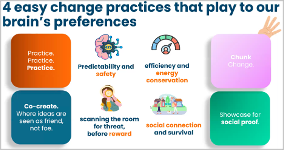Applied neuroscience can revolutionise Change Management practices
Brain-Friendly Change session was facilitated by Michelle Teunis, Lena Ross, and Dr Jen Frahm. It delivered an insightful exploration into how applied neuroscience can revolutionise Change Management practices. With deep expertise in organisational change, agility, and neuroscience, the speakers engaged participants in discussions around why now, more than ever, it is essential to adopt brain-friendly approaches to change. They shared research-driven insights into human behaviour, the neurological challenges people face during periods of intense change, and practical strategies for Change Managers to implement brain-friendly techniques in their work.
Michelle explained, 77% of HR leaders have reported that their employees are experiencing fatigue amidst this high-pressure environment. This reality underscores the need for Change Management that acknowledges and supports the brain’s natural limitations.
So, what exactly is brain-friendly change? According to the speakers, it is the integration of applied neuroscience into contemporary Change Management practices. This is not about clinical or theoretical neuroscience but practical, real-world application to make change more manageable for the human brain. The session explored five gifts of applying brain-friendly change:
- Reducing resistance
By understanding how the brain operates and anticipating its natural responses to change, resistance can be managed in a more proactive and empathetic way - Building authority and influence
As Change Practitioners become more attuned to the brain’s organising principles, they naturally shift from being seen as tactical operators to strategic change advisors - Making change feel effortless
Aligning change activities with the brain’s needs reduces the sense of effort and struggle, making change processes more natural - Boosting performance
When stress is reduced, people perform better. This approach fosters an environment where change can land more successfully - Ensuring that change sticks
By working with the brain’s processes around habit formation and adoption, Change Practitioners can create long-lasting change
The BIS and BAS model
The BIS and BAS model was introduced, which helps to clarify how our brains handle change. The behavioural inhibition system (BIS) is the brain’s “cautious” system, which triggers an alert or avoidance response to change. On the other hand, the behavioural approach system (BAS) seeks reward and drives approach behaviours. The balance between these two systems determines whether someone will embrace or resist change. The goal for Change Practitioners is to design experiences that tip the balance towards BAS, encouraging approach behaviours by minimising threat and maximising reward.

Neuroscience-backed Strategies
The speakers also introduced practical, neuroscience-backed strategies for designing change that resonates with the brain’s preferences:
- Co-creation
Working collaboratively in a safe space activates neurotransmitters like dopamine (for reward and motivation) and oxytocin (for social connection), fostering a sense of safety and control - Practise and repetition
Giving people the opportunity to practise the new behaviour in a safe space helps the brain adjust faster and build confidence – this approach also reduces the discomfort that arises when expectations and reality do not match - Social proof
Showcasing progress and success reduces the perception of risk, as people are more likely to engage in change when they see others doing the same - Chunking
Breaking change into small, manageable pieces helps reduce cognitive load and makes it easier for the brain to process and remember the information

Common pain points
In addition to these strategies, the speakers discussed how Change Practitioners can address common pain points, such as engaging leadership and dealing with resistance. Lena emphasised the importance of speaking the same language as leaders, focusing on progress and aligning conversations with their key performance indicators (KPIs). Neuroscience tells us that the brain naturally gravitates towards familiar information, a concept known as the mere exposure effect. By framing discussions in terms leaders understand—such as cost savings and productivity – practitioners can better connect with them and gain their support for change initiatives.
Reframing resistance
For managing resistance, Michelle offered a reframe: rather than seeing resistance as a problem, view it as the brain’s natural response to change. The brain is an energy conservationist, so change requires more effort, particularly after the age of 25, when neuroplasticity begins to slow down. By creating a positive perceived return on investment (ROI) for change – through clarity, simplicity, and small wins – Change Managers can encourage more people to engage rather than resist.
Self-regulation
Another valuable aspect of the session was the focus on self-regulation for Change Managers. Michelle reminded the audience that the ability to navigate change begins with self-navigation. By practising self-regulation, Change Managers can avoid emotional contagion, which occurs when stress and defensiveness spread within a team. The concept of the task-positive network (focused work mode) and the default mode network (rest and recharge) was introduced as a framework for managing mental energy. Simple practices like taking short breaks or walks can help Change Managers shift gears and avoid burnout.
Human-centred change
Finally, the speakers touched on the importance of human-centred change, which inherently aligns with brain-friendly principles due to its focus on inclusion and co-creation. Tools like journey mapping and personas help practitioners understand the pain points of their audience, allowing for more empathetic and effective change design. Lena reminded us that human-centred change encourages practitioners to park their ‘expert mindset’ and approach problems with curiosity and openness.
Conclusion
Brain-friendly change is not just a trend – it’s a necessary evolution in the way we approach Change Management. By understanding the science behind how our brains process change, practitioners can create more effective, empathetic, and lasting change within their organisations.
🎬 Members can watch the full webinar https://bit.ly/Brain-friendly-change
🤔 Not a member yet? Now is a great time to JOIN HERE NOW




